Are you ready to learn how to make a carpenter bee trap? I am here to tell you that we have had a problem this year. The dreaded carpenter bees have been at work around the farm. My husband made a trap and I thought I would share it here with y’all. You can use any scrap 4 x 4 you have to make a carpenter bee trap for your home. This is a simple project and it uses a mason jar! That is basically my kind of DIY project. Follow along with our carpenter bee trap plans below then start making your own version.
Don’t want to trap the carpenter bees? We have also found that this paper bag solution helps to deter them from eating our wood!
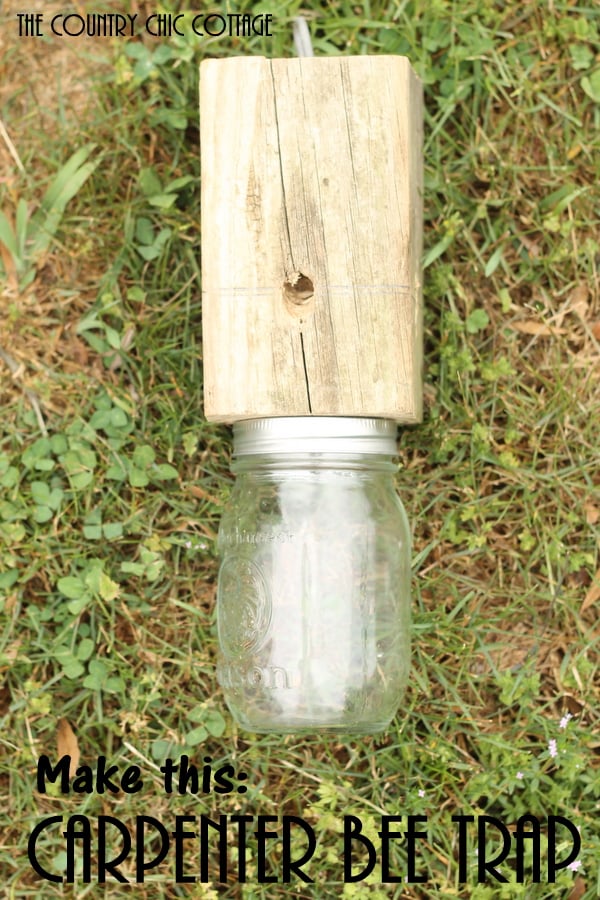
Supplies to make a wood bee trap:
- 4×4 cut to length (You can use a scrap 4 x 4 that is about 7 inches long for this project or purchase a new one if you don’t have any in your woodpile.)
- 15/16 inch drill bit
- 3/4 inch drill bit
- Drill
- Pint-sized mason jar with lid
- Saw
- Hook for hanging
- Screws
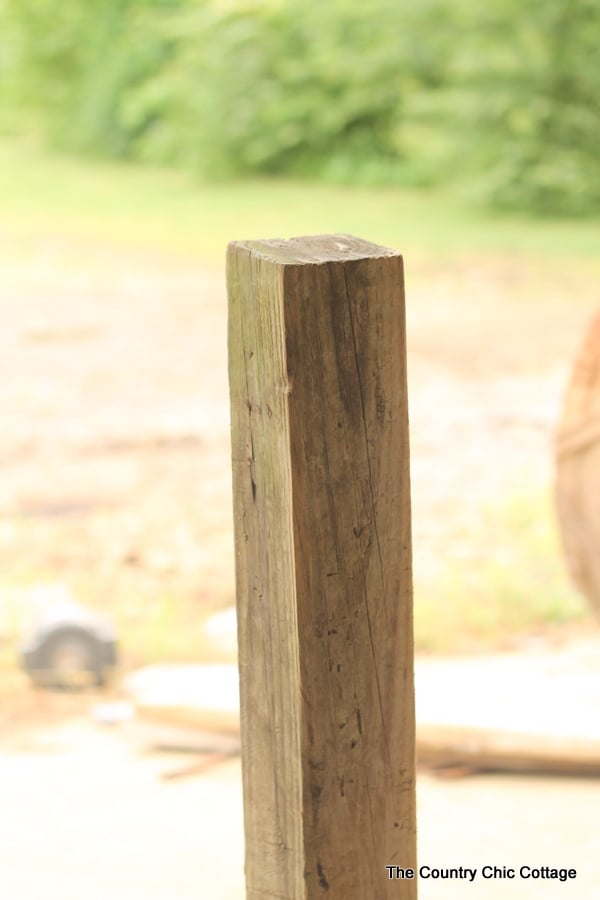
Want to buy a boring bee trap instead of making one?
So, you may know how to make a carpenter bee trap, but you may not WANT to make one. You can buy one instead! Try the Amazon widget below to buy a bore bee trap and give it a try around your home.
How to Make a Carpenter Bee Trap:
To begin, you will need to drill a hole in the center of your 4×4. We used a 15/16 inch drill bit, however, you can use one that is 1 inch or a little under. Drill your hole about 5 inches deep.
TIP: Wrap masking tape around your drill bit at the 5-inch mark. Then you know to stop drilling when the tape reaches the wood.
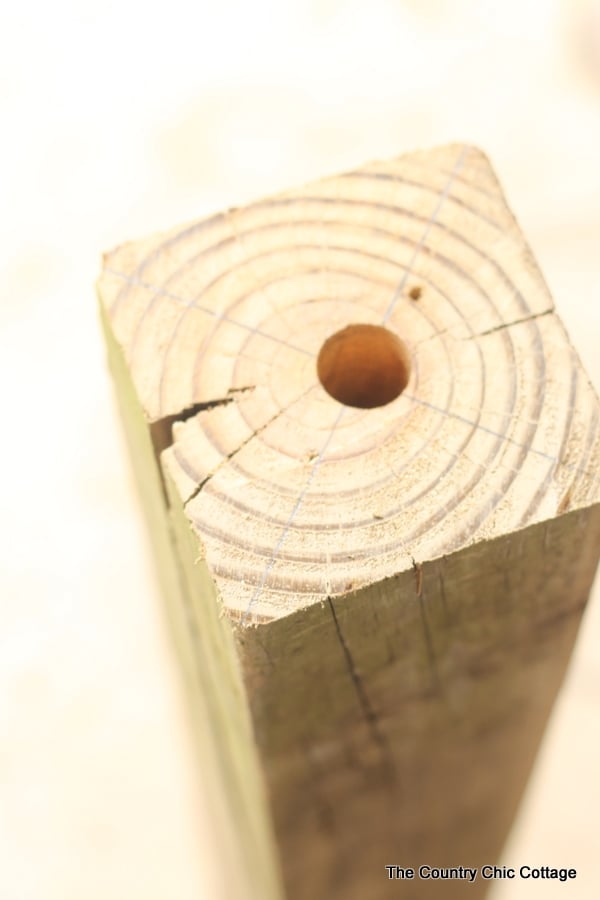
Mark up about 2 1/2 inches from the end that you just drilled the hole into. Then drill holes in the center of each side as shown below. Keep your drill at about a 45-degree angle. Drill until you reach the 5-inch deep hole that you put in the bottom. Here you will want to use about a 3/4 inch drill bit. Repeat this same procedure on all four sides.
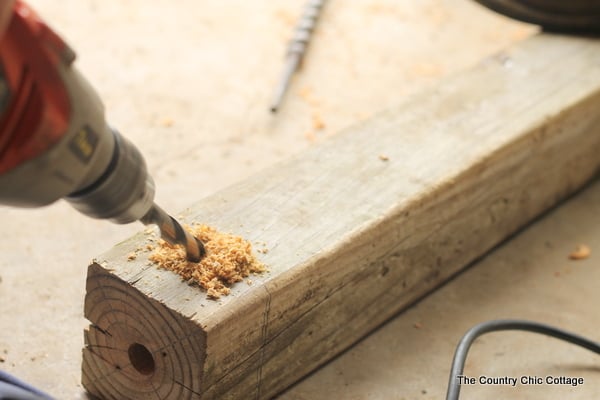
Now, if you have not already, you can cut off your 4 x 4 at around 7 inches long using a saw. Then just add some type of hook to the top for hanging.
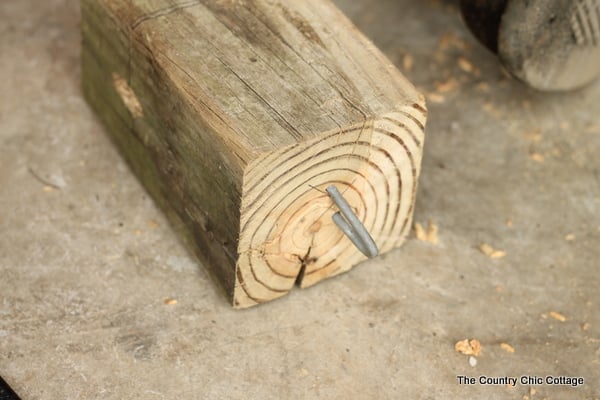
Add a larger hole to the center of your mason jar lid. You can use a large drill bit for this just be sure to clamp down the lid well. Then screw the lid onto the bottom of your trap. Be sure to align the hole in the lid with the hole in the bore bee trap.
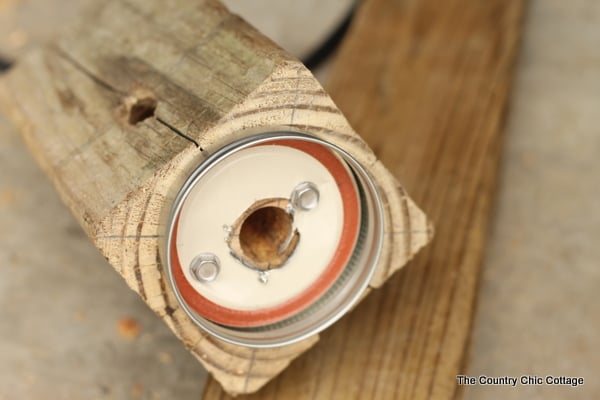
Finally, you just want to screw the mason jar onto the bottom of the trap.
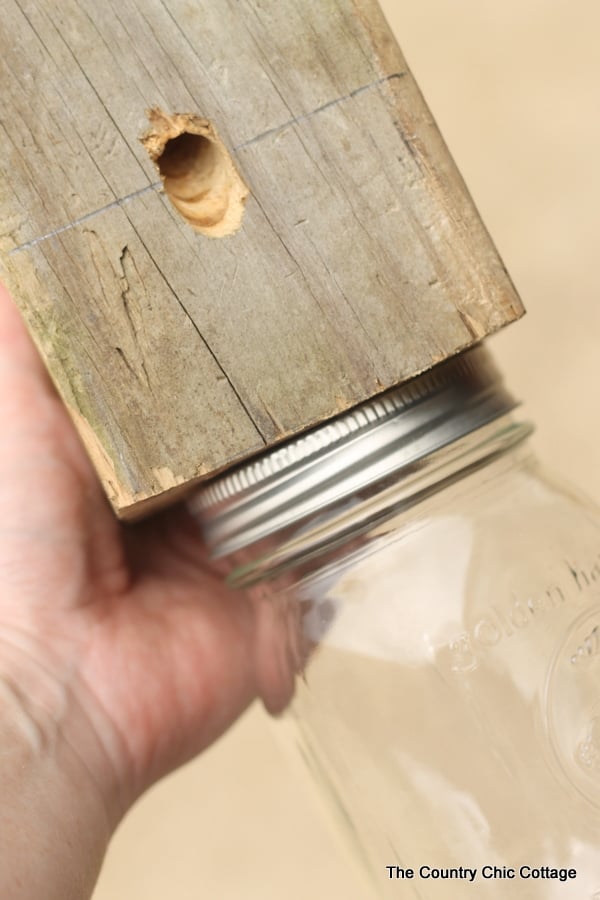
Now, you know how to make a carpenter bee trap. And this one is ready to hang and catch those carpenter bees. Want to see the entire process in a story? Just click to watch the slides below!
We gave ours a few weeks and I can definitely say it is working now! Be sure to use these carpenter bee trap plans to make a wood bee trap or two for around your home.
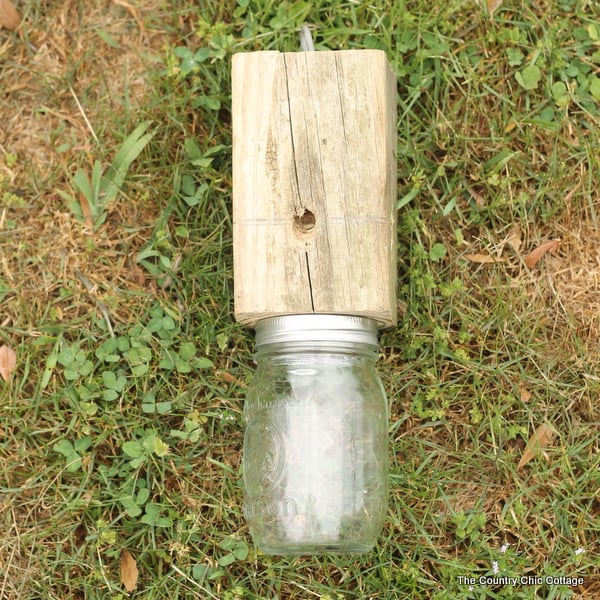
Love this DIY boring bee trap and want more ideas? Try the links below as well!
- Our Best Screened-in Porch Ideas
- How to Make Mosquito Repellent Candles
- DIY Scrap Wood Projects You Can Make
- How to Kill Weeds Not Flowers
- Shrinky Dink Butterfly Mobile
Want to print these carpenter bee trap plans? Try the printable card below!
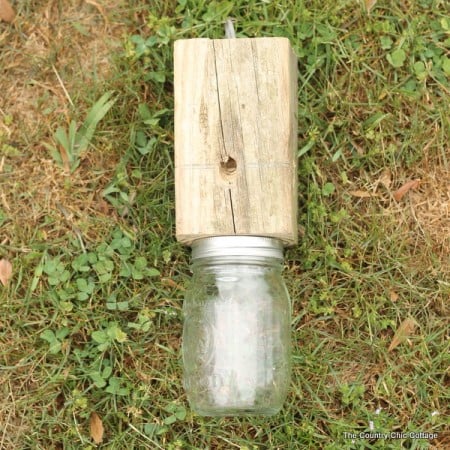
Equipment
- drill
- saw
Supplies
- 1 4×4 cut to length You can use a scrap 4 x 4 that is about 7 inches long for this project or purchase a new one if you don't have any in your woodpile.
- 15/16 inch drill bit
- 3/4 inch drill bit
- Pint-sized mason jar with lid
- Hook for hanging
- Screws
Instructions
- To begin, you will need to drill a hole in the center of your 4×4. We used a 15/16 inch drill bit, however, you can use one that is 1 inch or a little under. Drill your hole about 5 inches deep.
- TIP: Wrap masking tape around your drill bit at the 5-inch mark. Then you know to stop drilling when the tape reaches the wood.
- Mark up about 2 1/2 inches from the end that you just drilled the hole into. Then drill holes in the center of each side as shown below. Keep your drill at about a 45-degree angle. Drill until you reach the 5-inch deep hole that you put in the bottom. Here you will want to use about a 3/4 inch drill bit. Repeat this same procedure on all four sides.
- Now, if you have not already, you can cut off your 4 x 4 at around 7 inches long using a saw. Then just add some type of hook to the top for hanging.
- Add a larger hole to the center of your mason jar lid. You can use a large drill bit for this just be sure to clamp down the lid well. Then screw the lid onto the bottom of your trap. Be sure to align the hole in the lid with the hole in the bore bee trap.
- Finally, you just want to screw the mason jar onto the bottom of the trap.
A Year of Jar Crafts

Sign up for our email list to get a FREE book with an entire year of jar crafts! 12 months, 12 crafts, tons of fun!

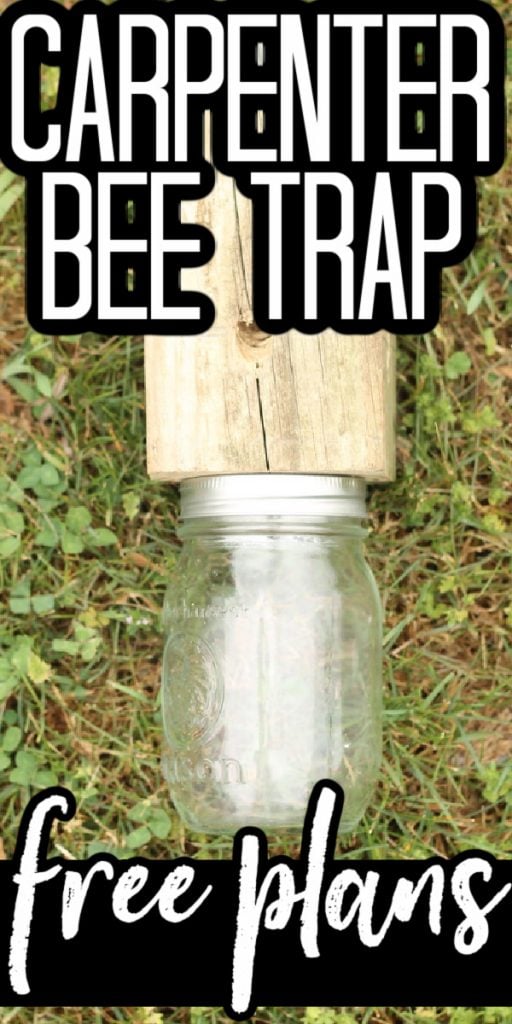
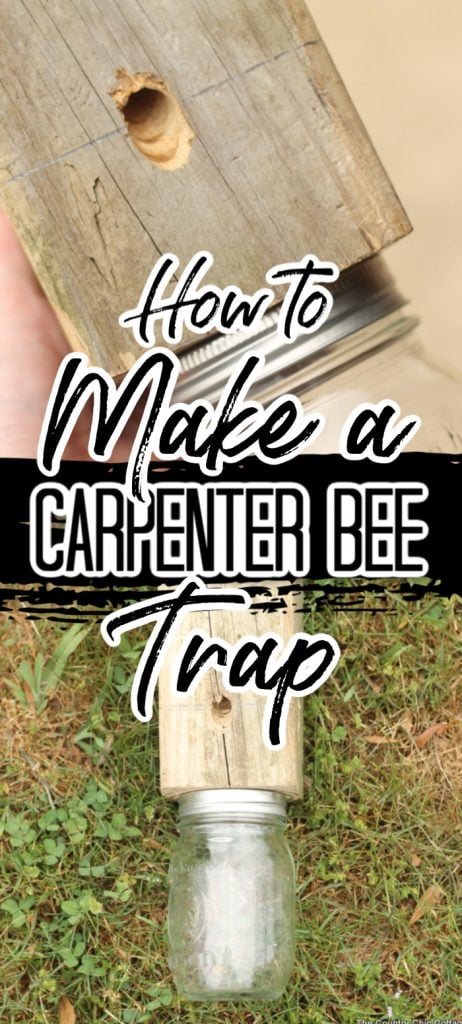










Don’t kill the bees! Carpenter bees are pollinators! Look it up! Do your own research before listening to someone else on the internet. They don’t eat wood. They get their names from the sounds they make. You can find ways to deter them, don’t kill them!
They may as well eat the wood for the damage they do. I’m pretty sure I’ve never ‘heard’ them sound like carpenters, but they do leave sawdust everywhere.
That’s incorrect. I have personally had an infestation of them, and I would have counted hundreds. They drill carpenter size tunnels that I’ve seen get up to 2 feet in length… They are aggressive with birds and anything else that gets near them. I believe you have confused them with the bumble bee which doesn’t eat wood.
I usually just use paint to deter them, that and fake hornet’s nests.
This is a comment to all of the bee lovers. They are destructive. I can see the sawdust or should I say bee dust from my fence rails like snow. I wouldn’t even kill mosquitos if they didn’t spread disease. If you have ever had to spend $$ on repairs you might change your view. It’s ok for you to use a toxic chemical to deter them? At least the trap doesn’t harm regular bees ir butterflies.
I’ve lived on this family farm for nearly 70 years. Never saw any carpenter bees until just a few years ago. So, apparently they have thrived so well that they are hunting new territory. Whether this is due to the loss of their normal control beast, climate change, or whatever I don’t know. However, they need some type of control due to the damage they do to wood structures. Traps won’t kill them all, only reduce this recent explosion to a more livable level. Much safer to use bee specific traps rather than chemicals that will kill non-target bugs and can cause a lot of problems to the ecology.
The “damage” they cause is harmless and doesn’t affect the structural soundness -it’s just visual. I have holes in m mailbox post that carpenter bees use every year and that post is just as strong as it was 15 years ago. Why not just let them have a place to live, just like you??
I have significant damage to my fence and some exposed wood under my gutters on my house due to carpenter bees, will have to be replaced. it’s even difficult to sit on my deck, they dive bomb us every time we walk out to to sit on my beautiful deck.
Letting them live in the wood creates more problems. Woodpeckers find them and then that leads to even more wood damage, which can easily becomes structural. Structural integrity is much more important on a home compared to a mailbox post. I don’t think people are making these to hang on their mailbox, although the mailman could appreciate that.
Amen! They’re terrible around my house and shop. Not only the mess and damage they create but the woodpeckers have ruined eaves of my shop that have to be replaced now. Apparently they are nowhere near extinction. They are thriving and a menace!!
Let us know where you live so we can release our bees there where they can be safe and thrive.
We had an infestation of them at a house we used to own when I was a kid and they did, indeed, affect the structure of our porch. We had to end up replacing several beams because they had weakened it to the point that it was about to cave in. Some of the boards had 20-30 holes in them that extended nearly the entire length of the porch.
My husband and I made some of these, but the holes drilled are not clean. You cannot see completely through. Will the bees bore through that, or do we need to keep drilling the hills to clean them out better? The entry holes are fine, it’s where the holes meet that’s a mess of wood pieces in the middle
We didn’t clean them out and it worked fine. Maybe if after a few days it doesn’t work, try cleaning out a bit more.
I made 9 of these ( just used the entire 4×4) and hung them up around the yard. So far in 2 days I have caught 7! No chemicals to attract the bees, they just get in and cannot get out! Thanks for the How Too!
Thank you for the instructions on making the carpenter bee trap.
How do they not back out of the holes?